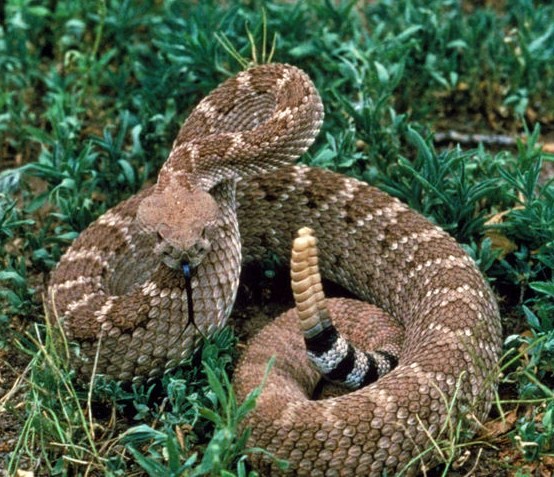
 Pit vipers are of the family Crotalinae, and are known by several species: Crotalus (rattlesnakes), Sistrurus (pigmy rattlesnakes and massassauga), and Agkistrodon (copperheads and cottonmouth water moccasins). These snakes have retractable fangs and can be distinguished by the heat-seeking pit located between the nostril and eye on their triangle-shaped heads. Their range is throughout the continental U.S. Bites most often occur in rural areas where these types of snakes are most frequent.
Pit vipers are of the family Crotalinae, and are known by several species: Crotalus (rattlesnakes), Sistrurus (pigmy rattlesnakes and massassauga), and Agkistrodon (copperheads and cottonmouth water moccasins). These snakes have retractable fangs and can be distinguished by the heat-seeking pit located between the nostril and eye on their triangle-shaped heads. Their range is throughout the continental U.S. Bites most often occur in rural areas where these types of snakes are most frequent.
Toxicity of the venom is considered hematoxic, which means that it causes blood poisoning in the victim. Several species have subpopulations with lethal neurotoxic venoms, meaning that the venom attacks the nervous system (e.g., Mojave rattlesnake). The general ranking of severity is: (1) rattlesnakes, (2) moccasins, (3) copperheads.
The venom causes local tissue injury and interferes with coagulation of the blood. It also affects the cardiovascular and respiratory systems. Eighty-five percent of bite victims have altered laboratory values and clinically important swelling, with severely low blood pressure from the pooling of blood within the nervous system or pulmonary (lung) vessels. Fluid loss is secondary to severe swelling.
In most dogs, there are puncture wounds on the head and forelimbs. In addition, symptoms may be delayed for 8 hours after bite, including:
Victim-associated
Snake-associated
You will need to give a thorough history of your dog’s health, recent activities and onset of symptoms. Unless you saw the snake bite your pet, the diagnosis may be complicated by the fact that many other things can cause the same symptoms. For example, insect bite, blunt trauma, penetrating wound, animal bite, penetration of foreign body, or a draining abscess can bring about many of the same symptoms of snakebite.
A complete blood profile will be conducted, including a chemical blood profile, a complete blood count, and a urinalysis. Your veterinarian will obtain important information from the blood test and urinalysis. Clotting tests can also indicate the origin of the symptoms, as clotting disorders are often a symptom of snakebite. Your doctor may also conduct an electrocardiogram to evaluate the functioning of your dog’s heart.
First aid measures will include calming your dog and keeping it still, as activity can move the venom through the system more rapidly. Transporting the dog quickly to a veterinary facility is important. There, intravenous fluids can be given to correct low blood pressure; oxygen can be given for breathing difficulties; and transfusions given for severe clotting problems.
If you are sure that your dog is a victim of snakebite, you will need to make this known to your veterinarian so that anti-venom serums can be given. The faster they can be injected, the better chance your dog has of a full recovery. Snakebites are also at risk of infection, warranting antibiotics to prevent infection, and sterile dressings applied to the wound.
Your veterinarian will want to repeat the laboratory analysis six hours after the initial treatment to make sure that your dog is progressing. The clinical signs may last as long as a week-and-a-half as your dog’s system recovers from the toxic reaction.
 Intestinal Tumor (Leiomyoma) in Dogs
Leiomyoma of the Stomach, Small, and Large Intestine in
Intestinal Tumor (Leiomyoma) in Dogs
Leiomyoma of the Stomach, Small, and Large Intestine in
 Bone Inflammation (Panosteitis) in Dogs
Panosteitis in Dogs
Panosteitis refers to a short
Bone Inflammation (Panosteitis) in Dogs
Panosteitis in Dogs
Panosteitis refers to a short
 Liver Disease (Copper Storage) in Dogs
Copper-Storage Hepatopathy in Dogs
Copper storage
Liver Disease (Copper Storage) in Dogs
Copper-Storage Hepatopathy in Dogs
Copper storage
 Joint Dislocation in Dogs
Joint Luxations in Dogs
Bone acts as the architec
Joint Dislocation in Dogs
Joint Luxations in Dogs
Bone acts as the architec
 Lungworms in Dogs
Parasitic Respiratory Infections in Dogs
Lungworm
Lungworms in Dogs
Parasitic Respiratory Infections in Dogs
Lungworm
Copyright © 2005-2016 Pet Information All Rights Reserved
Contact us: www162date@outlook.com